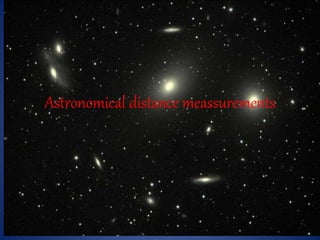
Astronomical distance meassurements.pptx
- 2. Units • A U (astronomical unit) The distance between sun and earth. aproximately 1.5X1015m
- 3. Light Year (L Y) • Distance the light travels in one year • 1 LY = 9.46X1015 m
- 4. Parsec • This is the distance of a star with a parallax angle of 1 arcsec. • 1 parallax-second = 1 parsec = 3.08X1016m • =206,265 au. • 1 parsec = 3.26 LY
- 5. Trigonometric Parallax - The stellar parallax is the apparent motion of a star due to our changing perspective as the Earth orbits the Sun. -parsec: the distance at which 1 AU subtends an angle of 1 arcsec.
- 6. 1/360 = 1 degree 1/60 degree = 1 arcminute 1/60 arcminute = 1 arcsecond
- 7. Stellar Parallax • The Distance to a star is inversely proportional to the parallax angle. • There is a special unit of distance called a parsec. • This is the distance of a star with a parallax angle of 1 arcsec.
- 8. How parallax measurements can be used to determine the distances.? • The star is viewed from two positions at 6 month intervals • The change in angular position of the star against backdrop of distant/fixed stars is measured • Trigonometry is used to calculate the distance to the star The diameter/radius of the Earth’s orbit about the Sun must be known
- 9. Luminosity (L) • Energy radiated from a star in all directions in one second. • It is similar to the power of a star.
- 10. Radiation flux (F) • Radiation flux, is the amount of power radiated through a given area, in the form of electromagnetic radiations (photons) or other elementary particles, typically measured in W/m2
- 11. Inverse Square Law • 𝐹 = 𝐿 4𝜋𝑑2 F= radiation flux L= Luminosity d= distance
- 12. Standard candle • StandardCandles—astronomical objects with known luminosity. Main sequence stars. Cepheid variables. White dwarf supernovae. Galaxies
- 13. Cepheid Variables Cepheid variable stars are population I (metal-rich) yellow giant stars with periodic luminosity variation…. • Their periods range from a few days to over 100 days, • Their luminosities range from 1000 to 30,000 L⊙, • The high luminosity makes it possible to identify them from a large distance… • Their luminosity and period are strongly correlated. Therefore, we can determine their luminosity by simply measuring their periods! The luminosity of Cepheid variabls are strongly correlated to their periodicity…
- 14. Tully-Fisher Relation Although this is not discussed in our text book, the luminosity of the spiral galaxies are related to their rotational speed,. This was discovered by B. Tully (of UH/IfA) and J.R. Fisher in 1977. Therefore, the luminosity of the spiral galaxies can be determined simply by measuring their rotational speed… Spiral galaxies are good standard candles also! The slope of the luminosity-rotation rate curve is different for different type of spiral galaxies…
- 15. White Dwarf Supernova Every time the hydrogen shell is ignited, the mass of the white dwarf may increase (or decrease, we don’t know for sure yet). • The mass of the white dwarf may gradually increase, • At about 1 M⊙, the gravitation force overcomes the electron degenerate pressure, and the white dwarf collapses, increasing temperature and density until it reaches carbon fusion temperature. • The carbon inside the white dwarfs are simultaneously ignited. It explodes to form a White dwarf supernova. (Type I). • Nothing is left behind from a white dwarf supernova explosion (In contrast to a massive-star supernova, which would leave a neutron star or black hole behind). All the materials are dispersed into space. White Dwarf Supernova is a very important standard candle for measuring cosmological distance…
- 16. How a standard candle can be used to measure distance.? • Standard candles are astronomical objects of known luminosity (L). • Locate the standard candle. • Measure the brightness/flux/intensity (F), of the star • Use inverse square law 𝐹 = 𝐿 4𝜋𝑑2 • calculate the distance d.
- 17. Distance and Redshift In addition to distance, Hubble also measured the redshift of the galaxies…and when combined with distances derived from observation of Cepheid variables and the brightest stars in galaxies, Hubble found that, the more distant a galaxy, the greater its redshift is, and hence the faster it is moving away from us… → the universe is expanding!
- 18. Doppler Shift Formula: (OK if v << c) c v 0 z Radial velocity (can be +ve or –ve) Speed of light Wavelength of light as measured in the laboratory Change in wavelength (can be +ve or –ve) redshift
- 19. Hubble’s Law From the redshift and distance measurements, we can express the recession speed V of a galaxy located at a distant d away from us by V = d H0 The value of the Hubble’s Constant is H0 = 20~24 [km/sec] / million light-year Once the value of H0 is determined, we can use measured recession speed to infer the distance of galaxies using the formula d = V / H0
- 20. H0 has units of (time)-1 – usually measured in kilometres per second per Megaparsec H0 -1 = Hubble time = timescale for the expansion age of the Universe Hubble’s Law v = H0 d Hubble’s constant distance Radial velocity It tells us how fast the Universe is expanding
- 21. Thank you..